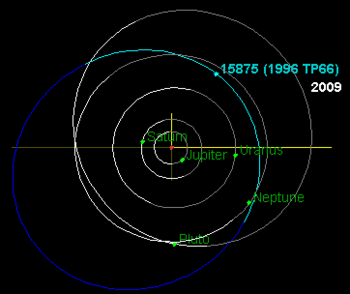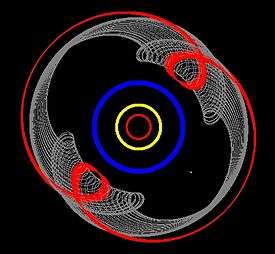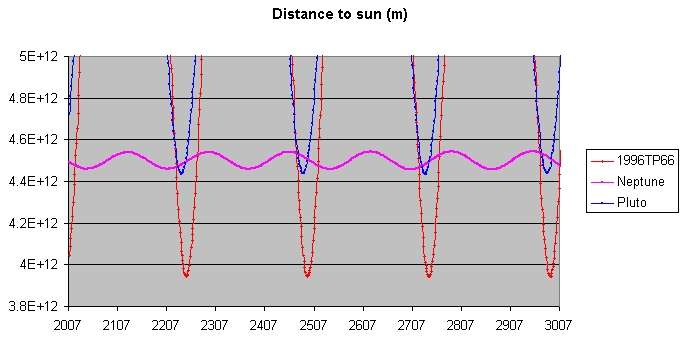(15875) 1996 TP66
| Discovery | |
|---|---|
| Discovered by | C. Trujillo, D. C. Jewitt, and J. X. Luu |
| Discovery date | 11 October 1996 |
| Designations | |
| MPC designation | (15875) 1996 TP66 |
| none | |
| TNO (plutino)[1][2][3] | |
| Orbital characteristics[4] | |
| Epoch 13 January 2016 (JD 2457400.5) | |
| Uncertainty parameter 3 | |
| Observation arc | 4394 days (12.03 yr) |
| Aphelion | 52.393 AU (7.8379 Tm) |
| Perihelion | 26.396 AU (3.9488 Tm) |
| 39.395 AU (5.8934 Tm) | |
| Eccentricity | 0.32995 |
| 247.27 yr (90313.6 d) | |
Average orbital speed | 4.63 km/s |
| 22.713° | |
| 0° 0m 14.35s / day | |
| Inclination | 5.6877° |
| 316.854° | |
| 75.552° | |
| Earth MOID | 25.4058 AU (3.80065 Tm) |
| Jupiter MOID | 21.4707 AU (3.21197 Tm) |
| TJupiter | 5.301 |
| Physical characteristics | |
| Dimensions |
154.0+28.8 −33.7 km[5] |
|
0.074+0.063 −0.031[5] | |
| Temperature | ~44 K |
|
1.03±0.11 0.66±0.07[5] | |
| 21.0[6] | |
|
7.51±0.09,[5] 6.79±0.33[7] 7.0[4] | |
|
| |
(15875) 1996 TP66, also written as (15875) 1996 TP66, is a resonant trans-Neptunian object in 2:3 resonance with Neptune, like Pluto (plutino). It was discovered on 11 October 1996 by Chad Trujillo, David C. Jewitt, and Jane X. Luu at the Mauna Kea Observatory, Hawaii.
Inside the orbit of Neptune
This plutino is currently 27 AU from the Sun,[6] and came to perihelion (q=26.3 AU) in 2000.[4] This means that this small plutino is currently well inside the orbit of the planet Neptune. Like Pluto, this plutino spends part of its orbit closer to the Sun than Neptune. Like all resonant trans-Neptunian objects its orbit is dominated by Neptune. Simulations by the Deep Ecliptic Survey (DES) show that over the next 10 million years 1996 TP66 can acquire a perihelion distance (qmin) as small as 25.9 AU.[1]
 This small plutino is currently well inside the orbit of Neptune even though its orbit is dominated by Neptune. |
 The motion of (15875) 1996 TP66 (red) and Pluto (grey) in a rotating frame with a period equal to Neptune's orbital period. (Neptune is held stationary.) |
Probable dwarf planet Huya and plutino (120216) 2004 EW95 are also currently inside the orbit of Neptune.
Calculations by the Minor Planet Center in 1997 showed that the eccentric orbit of (15875) 1996 TP66 comes within 6.9 AU of Uranus and stays more than 22.6 AU from Neptune over a 14,000-year period centered on the present.[3]
Physical properties
The size of 1996 TP66 was estimated by the Herschel Space Telescope to be 154.0+28.8
−33.7 km.[5] The object has a very red surface in the visible and a flat featureless infrared spectrum.[7][8]
References
- 1 2 Marc W. Buie. "Orbit Fit and Astrometric record for 15875" (2003-10-24 using 66 observations). SwRI (Space Science Department). Retrieved 2009-02-28.
- ↑ "MPEC 2009-A63 :Distant Minor Planets (2009 JAN. 29.0 TT)". Minor Planet Center. 2009-01-13. Retrieved 2009-02-28.
- 1 2 "MPEC 1997-N03: 1996 TP66". Minor Planet Center. 1997-07-02. Retrieved 2009-03-25.
- 1 2 3 "JPL Small-Body Database Browser: 15875 (1996 TP66)" (2003-10-24 last obs). Retrieved 8 April 2016.
- 1 2 3 4 5 Mommert, Michael; Harris, A. W.; Kiss, C.; Pál, A.; Santos-Sanz, P.; Stansberry, J.; Delsanti, A.; Vilenius, E.; Müller, T. G.; Peixinho, N.; Lellouch, E.; Szalai, N.; Henry, F.; Duffard, R.; Fornasier, S.; Hartogh, P.; Mueller, M.; Ortiz, J. L.; Protopapa, S.; Rengel, M.; Thirouin, A. (May 2012). "TNOs are cool: A survey of the trans-Neptunian region—V. Physical characterization of 18 Plutinos using Herschel-PACS observations". Astronomy & Astrophysics. 541: A93. arXiv:1202.3657. Bibcode:2012A&A...541A..93M. doi:10.1051/0004-6361/201118562.
- 1 2 "AstDys (15875) 1996TP66 Ephemerides". Department of Mathematics, University of Pisa, Italy. Archived from the original on 2009-04-18. Retrieved 2009-03-23.
- 1 2 Doressoundiram, A.; Peixinho, N.; Moullet, A.; Fornasier, S.; Barucci, M. A.; Beuzit, J. -L.; Veillet, C. (2007). "The Meudon Multicolor Survey (2MS) of Centaurs and Trans-Neptunian Objects: From Visible to Infrared Colors". The Astronomical Journal. 134 (6): 2186. Bibcode:2007AJ....134.2186D. doi:10.1086/522783.
- ↑ Barkume, K. M.; Brown, M. E.; Schaller, E. L. (2008). "Near-Infrared Spectra of Centaurs and Kuiper Belt Objects". The Astronomical Journal. 135: 55. Bibcode:2008AJ....135...55B. doi:10.1088/0004-6256/135/1/55.
